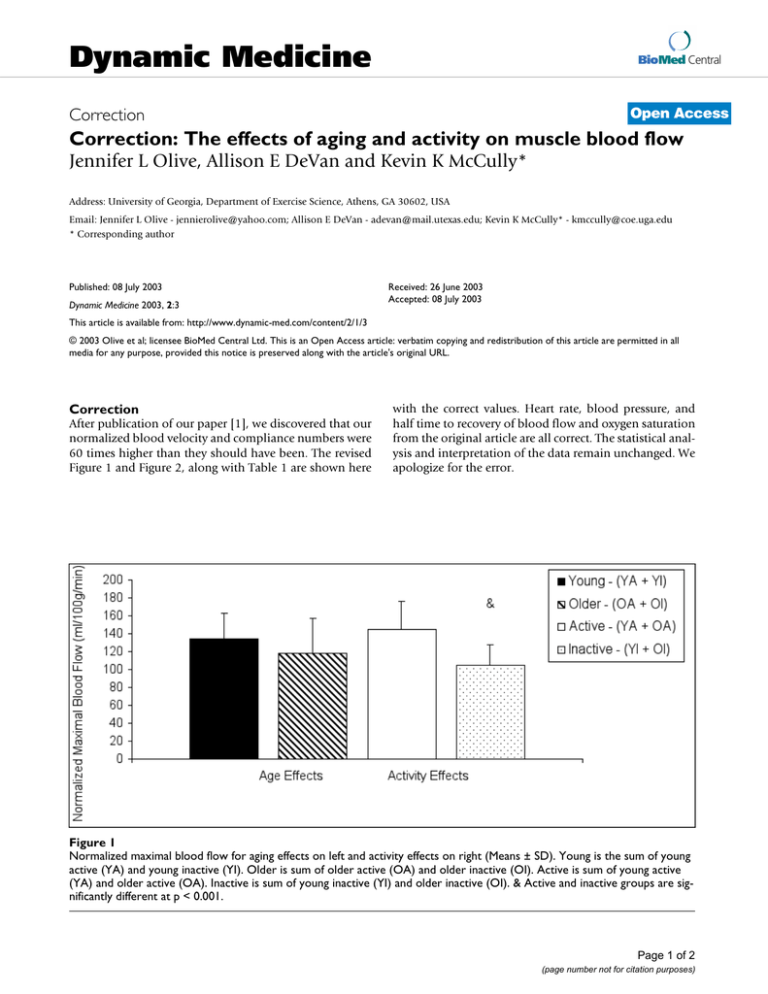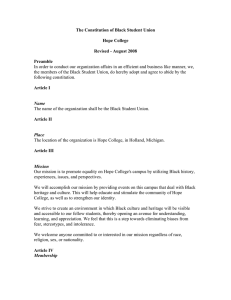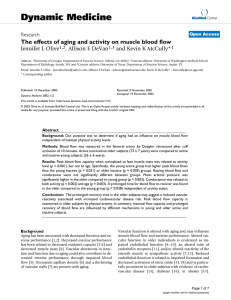Dynamic Medicine Correction
advertisement

Dynamic Medicine BioMed Central Open Access Correction Correction: The effects of aging and activity on muscle blood flow Jennifer L Olive, Allison E DeVan and Kevin K McCully* Address: University of Georgia, Department of Exercise Science, Athens, GA 30602, USA Email: Jennifer L Olive - jennierolive@yahoo.com; Allison E DeVan - adevan@mail.utexas.edu; Kevin K McCully* - kmccully@coe.uga.edu * Corresponding author Published: 08 July 2003 Dynamic Medicine 2003, 2:3 Received: 26 June 2003 Accepted: 08 July 2003 This article is available from: http://www.dynamic-med.com/content/2/1/3 © 2003 Olive et al; licensee BioMed Central Ltd. This is an Open Access article: verbatim copying and redistribution of this article are permitted in all media for any purpose, provided this notice is preserved along with the article's original URL. Correction After publication of our paper [1], we discovered that our normalized blood velocity and compliance numbers were 60 times higher than they should have been. The revised Figure 1 and Figure 2, along with Table 1 are shown here with the correct values. Heart rate, blood pressure, and half time to recovery of blood flow and oxygen saturation from the original article are all correct. The statistical analysis and interpretation of the data remain unchanged. We apologize for the error. Figure 1 maximal blood flow for aging effects on left and activity effects on right (Means ± SD) Normalized Normalized maximal blood flow for aging effects on left and activity effects on right (Means ± SD). Young is the sum of young active (YA) and young inactive (YI). Older is sum of older active (OA) and older inactive (OI). Active is sum of young active (YA) and older active (OA). Inactive is sum of young inactive (YI) and older inactive (OI). & Active and inactive groups are significantly different at p < 0.001. Page 1 of 2 (page number not for citation purposes) Dynamic Medicine 2003, 2 http://www.dynamic-med.com/content/2/1/3 Figure Conductance 2 of normalized maximal blood flow for aging effects on left and activity effects on right (Means ± SD) Conductance of normalized maximal blood flow for aging effects on left and activity effects on right (Means ± SD). Young is the sum of young active (YA) and young inactive (YI). Older is sum of older active (OA) and older inactive (OI). Active is sum of young active (YA) and older active (OA). Inactive is sum of young inactive (YI) and older inactive (OI). * Young and older groups are significantly different at p = 0.003. & Active and inactive groups are significantly different at p = 0.002. Table 1: Flow data and half time to recovery data for groups – Means (SD) Normalized Resting Blood Flow (ml/100 g/min) Resting Conductance (ml/100 g/min/mmHg) Normalized Maximal Blood Flow (ml/100 g/min) Maximal Conductance (ml/100 g/min/mmHg) Half Time to Recovery of Blood Flow (seconds) Half Time to Recovery of NIRS (seconds) Young Active Young Inactive Older Active Older Inactive 14.2 (8.3) 0.16 (0.08) 152 (13.7)* 1.71 (0.26)# 55 (12) 24 (17) 9.0 (6.2) 0.12 (0.08) 110 (29.1) 1.36 (0.36) 51 (20) 20 (8) 8.8 (2.7) 0.091 (0.03) 135 (45.9) 1.37 (0.39) 60 (9) 25 (21) 14.7 (8.3) 0.14 (0.078) 101 (20.1) 0.99 (0.15) 75 (31) 37 (21) Notes: * Significantly different than young inactive (p = 0.031) and older inactive (p = 0.005). # Significantly different than the older inactive (p < 0.001). References 1. Olive J, DeVan A and McCully K: The effects of aging and activity on muscle blood flow Dynamic Medicine 2002, 1:2. Publish with Bio Med Central and every scientist can read your work free of charge "BioMed Central will be the most significant development for disseminating the results of biomedical researc h in our lifetime." Sir Paul Nurse, Cancer Research UK Your research papers will be: available free of charge to the entire biomedical community peer reviewed and published immediately upon acceptance cited in PubMed and archived on PubMed Central yours — you keep the copyright BioMedcentral Submit your manuscript here: http://www.biomedcentral.com/info/publishing_adv.asp Page 2 of 2 (page number not for citation purposes)



